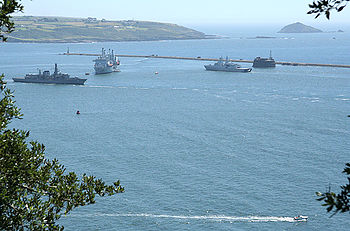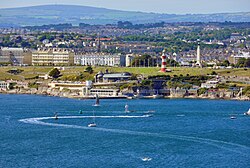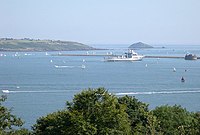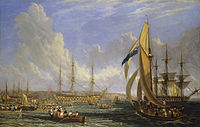Plymouth Sound

Plymouth Sound is a busy bay on the south coast of Great Britain around whose long shore stands the City of Plymouth in Devon. The Sound forms a large, sheltered natural harbour on the English Channel which has allowed Plymouth's several harbours to grow and thrive. At its west side it forms the mouth of the River Tamar, with Devonshire to its east side and Cornwall to its west, and to the east the River Plym enters the Sound by Sutton Harbour.
The southwest and southeast corners of Plymouth Sound are Penlee Point in Cornwall and Wembury Point in Devon, a distance of about 3 nautical miles. Its northern limit is Plymouth Hoe giving a north-south distance of nearly 3 nautical miles. At the seaward side the Sound is protected by Plymouth Breakwater
The Sound has three water entrances. The marine entrance is from the English Channel to the south, with a deep-water channel to the west of the Plymouth Breakwater. There are two freshwater inlets: one, from the northwest, is from the River Tamar through the Hamoaze and Devonport Dockyard, the largest naval dockyard in western Europe. The other, at northeast, is from the River Plym disgorging into its narrow estuary, Cattewater harbour between Mount Batten and the Royal Citadel.
In addition to ships of the Royal Navy, large commercial vessels, including ferries to France and Spain use the Sound from Millbay Docks. Fishing vessels use it from Sutton Harbour beside the old town of Plymouth, called the Barbican. There are marinas at Sutton Harbour, Mount Wise in the Hamoaze and at Turnchapel. Waterborne traffic in the Sound is controlled by the Queen's Harbour Master for Plymouth.[1][2]
Features within the Sound

In the centre of the Sound, midway between Bovisand Bay and Cawsand Bay, is Plymouth Breakwater, which creates a harbour protecting anchored ships from the frequent south-western storms. The breakwater is around 1,700 yards long, stands in around 36 feet of water. It was built by John Rennie and Joseph Whidbey starting in 1812. Standing on the western end of the breakwater is a lighthouse 75 feet tall and a 30-foot tall beacon with a spherical cage on top at the eastern end. It is said that the cage is a lifesaving device designed to keep wrecked sailors from drowning in the huge waves of a storm on the low-lying breakwater.
Drake's Island is a natural island in the sound, 450 yards long and around 100 yards broad standing before the mounth of the channel of the Tamar, and in the north of the Sound. It was fortified to defend Drake's Channel, the only deep-water route to Devonport. The Bridge is a shallow reef that links Drake's Island and the Cornish mainland. At low water the depth of the Bridge can be less than three feet but at high water it can rise to 15 feet (two and a half fathoms). In the First World War this natural barrier was supplemented by other obstructions to prevent submarines and small ships attacking the naval base.

Mount Batten is a peninsula jutting into the north-east corner of the bay, which might in ages past have been a tidal island. It was once a Royal Air Force flying boat and search and rescue base. T E Lawrence was stationed here as Aircraftman Shaw.
Over the years, the Sound has been defended by Drake's Island, Picklecombe Fort, Cawsand Fort, the Breakwater Fort, Fort Bovisand, Staddon Fort and Stamford Fort.
A harbour and reservoir were built at Bovisand before the fort existed to supply men-o-war anchored in the Sound with fresh water. Joseph Whidbey supervised the building of the Breakwater from Bovisand Lodge, from which there is a view down the full length of the breakwater.
Miscellany
- The English Fleet assembled in 1355: by Edward of Woodstock, the Black Prince, Duke of Cornwall, gathered in the Sound, from which they departed to France and the Battle of Poitiers
- The Pelican 15 November 1577: departed on Sir Francis Drake's circumnavigation – it was renamed Golden Hind during the voyage.
- In 1588 the English Fleet emerged from Plymouth Sound to fight the Spanish Armada

- The first recorded submarine fatality in history occurred in the Sound in June 1774, when a carpenter named John Day perished north of Drake's Island while testing a wooden diving chamber attached to the sloop Maria.[3]
- Following his surrender to Captain Frederick Maitland of HMS Bellerophon off Rochefort in 1815, Napoleon was brought to Plymouth Sound where he remained aboard from 26 July to 4 August, while his future was decided.[4] This event caused a local and national sensation as thousands took to the water, and painters recorded the scene.
- On 27 December 1831, HMS Beagle set off from an anchorage in the Barn Pool, under Mount Edgecumbe on the Cornish side of Plymouth Sound, on her second survey voyage Robert FitzRoy with Charles Darwin aboard.[5]
The Titanic, which sailed in 1912, was scheduled to dock briefly in Plymouth on its return voyage to Britain, and the ship had a painting of Plymouth Sound aboard.
The Sound has been the site of a number of aircraft crashes and shipwrecks:
- Die Fraumetta Catharina von Flensburg, a 53-ton brigantine, sank near Drake's Island in December 1786.
- The P&O ship Nepaul sank on the Shagstone in December 1890.
- A Short Sunderland flying boat crashed in March 1942 between the Breakwater Fort and the breakwater lighthouse killing five passengers.
- In February 1943, a Lancaster bomber hit the cable of a barrage balloon and crashed without survivors on the return from a raid on the U-boat pens at Lorient.
- The Glen Strathallan luxury steam yacht was scuttled near the Shagstone as a site for scuba diving. This ship's triple expansion steam engine is now on display in the Science Museum in London.
Outside links
| ("Wikimedia Commons" has material about Plymouth Sound) |
- Location maps: 50°20’35"N, 4°8’35"W, SX4751
- Plymouth Breakwater, at The Encyclopaedia of Plymouth History
References
- ↑ Queen's Harbour Master Plymouth
- ↑ The Dockyard Port of Plymouth Order 1999
- ↑ Ecott, Tim (2001). Neutral Buoyancy: Adventures in a Liquid World. New York: Atlantic Monthly Press. ISBN 0-87113-794-1.
- ↑ National Maritime Museum Collections
- ↑ FitzRoy, R. 1839. Narrative, p. 42.
Keynes, R. D. ed. 2001. Charles Darwin's Beagle diary, pp 4–17
- Fort Bovisand: Kendal McDonald ISBN 0-9528637-1-5
